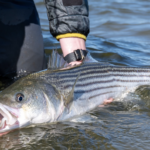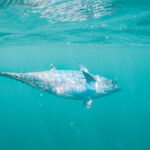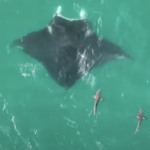
Talkin’ Striped Bass Spawn Dynamics
Consistent spawning production is paramount to a fishery’s long-term health. Many environmental factors are suspected
By Will Poston, Policy Associate
Today’s offshore wind (OSW) dialogue is constantly shifting, with numerous projects in various stages of development. It seems like every week a new lease is approved, more science is published, or another thousand-page document is released by the Bureau of Ocean Energy Management (BOEM) for public review and comment. It’s exhausting, for sure, but we at ASGA remain committed to ensuring this rapidly growing industry proceeds compatibly with sustainable fisheries and healthy marine ecosystems. If you’re new to the OSW discussion, be sure to check out our Wind Policy Platform, which we released in May 2021. Follow along for a rapid-fire download about some noteworthy OSW updates and what we are paying special attention to from a recreational perspective.
Since we last posted an OSW blog in January, a lot has happened in this ever-evolving industry. Currently there are only two approved commercial OSW projects—Vineyard Wind 1 and South Fork Wind—but Ocean Wind 1 (NJ) and Revolution Wind (RI) are not too far behind, with numerous other projects in the works. Here is a high-level description of the projects mentioned above:
Last winter, BOEM held an auction for six leases in the New York Bight Area totaling almost half a million acres, which set a record lease sale (for wind leases as well as those for oil and gas) of $4.37 billion. Now the projects will begin conducting monitoring and site assessments and then develop their Construction and Operation Plans to submit to BOEM for approval. One interesting development for this specific area is BOEM’s intention to conduct a region-wide Programmatic Environmental Impact Statement (PEIS) for the entire NY Bight area, a departure from the traditional project-specific approach. Scoping comments to help inform the development of this PEIS are due on August 30.
We like the approach of considering the impacts of nearby lease areas jointly in a PEIS, as it will look at the effect OSW on the region more holistically than the patchwork of leases and EISs we see now (such as south of Martha’s Vineyard). Marine ecosystems are dynamic and do not occur in a bubble, and fisheries definitely don’t. With this region’s proximity to several large population centers, there is a ton of recreational and for-hire angling effort in this area as well. Whether it’s demersal (bottom) species or run-and-gun tuna fishing, these are popular fishing grounds which we need collective baseline information for. So, this new process has promise to take a bigger picture of the whole area and identify potential impacts caused by OSW.
BOEM recently released a Draft EIS for Ocean Wind 1, a project 15 miles off the coast of Southern NJ that could include up to 98 wind turbines. The release of the DEIS kicks off another public comment period, for which comments are due on August 23. BOEM will then review comments and issue a final EIS and thereafter will publish a Record of Decision identifying which alternative(s) is approved. Right now, we’re working our way through the 1,400-page DEIS, but plan to submit formal comments before the deadline, and we encourage you to do the same if this area is of interest to you.
While our focus when it comes to OSW certainly centers on the fishery and ecological impacts, we are tracking another BOEM effort—the Draft Fisheries Mitigation Strategy—which will develop a framework to avoid and minimize, or compensate for OSW-related impacts to fishermen. We are drafting a comment now that will focus more so on the ways OSW projects can be designed from the get-go to minimize impacts to marine ecosystems and recreational fisheries. This document presents a good opportunity to advocate for common-sense recommendations such as requiring/encouraging nature-inclusive designs and materials for scour protection and other project aspects, buffer zones or travel corridors between adjacent leases, shared transport cables, and methods for developers to share research/data with NOAA Fisheries scientists. Comments on the Draft Strategy are due on August 22.
Science has no endpoint; it’s always advancing, and research efforts related to OSW impacts on fisheries and the marine environment more broadly is no different. Ever since the OSW discussion started on the U.S. east coast, the pace and scope of scientific research have lagged sorely behind the rate of permitting/development. In an ideal world, we’d have a full suite of baseline data and studies to help us better predict and detect impacts of this new use on our oceans, as well as tools to help fishermen better adapt to an increasingly crowded ocean. However, we are where we are, and are grateful for members of the research community who are hustling to get us vital information even as construction has already gotten underway for some projects.
Last February, the National Academies of Sciences released a very relevant study for offshore anglers and boaters: Wind Turbine Generator Impacts on Marine Vessel Radar. When guides and anglers venture offshore, safety is the number one priority—there is very little room for error when you’re way out there. While these wind turbine generators are going to be massive, lit up, and hard to miss, this study is discovering that they are substantially interfering with radar systems: “Wind turbines in the maritime environment affect marine vessel radar in a situation-dependent manner, with the most common impact being a substantial increase in strong, reflected energy cluttering the operator’s display, leading to complications in navigation decision-making.”
The study recommends that BOEM should continue to fill data gaps and pursue existing opportunities to adapt and improve marine vessel radar systems. Based on the report, there seems to be a suite of possible solutions or strategies to mitigate this impact, but we will be paying close attention to these developments and working to ensure that they’re implemented to make offshore trips as safe as possible.
Another research topic of particular concern to ASGA—and plenty of you all, I’m sure—involves acoustic tagging of highly migratory species (HMS; in this case tunas, sharks, and white marlin) in the Southern New England wind lease areas. Most of us know that there is a ton of recreational fishing effort in this area. However, we have very little baseline information regarding where the fish caught in this area spend most of their time, which will make it impossible to assess what the impacts of OSW development will be on their movements and distribution. Scientists are working to change that. You can learn more about this acoustic tagging work here.
Some of our good friends are involved in these efforts also. Dr. Jeff Kneebone, who we’re working with for our false albacore tagging project (also a baseline data collection effort), has been chasing tunas most of the summer to deploy acoustic tags into fish to get a better idea for how they use the wind energy areas. When we talked with Jeff for an albie podcast a couple of weeks ago, he was cursing the inconsistent bite. But based on some more recent reports, I think he’s finding them.
One of the most concerning known effects of OSW development will be its impact to federal fishery-independent surveys that have time-series going back more than 50 years and form the backbone of the stock assessment process. In May, ASGA submitted a comment letter to BOEM and NOAA on the Federal Survey Mitigation Implementation Strategy for the Northeast Region. This strategy, while essential for the long-term maintenance of these surveys, lacked actionable ways to adapt surveys. So, our comments provided general support but also emphasized the present opportunity to integrate some of the scientific work being done by OSW developers into fisheries surveys. No matter how we adapt these surveys to operate with OSW, one thing is abundantly clear—NOAA and other agencies will need the funding to carry out the work. That’s why, in June, we submitted a letter to Congressional appropriators (the politicians who determine how much money different parts of the government receive for their annual budgets) requesting sufficient federal resources for survey impact mitigation efforts. We were grateful to be joined by stakeholders from the commercial, environmental, and OSW industry communities in this effort.
If you thought we were exaggerating about how much is happening with OSW, you now understand. There is a lot going on—so much so that state agencies are desperately adding full time staffers just to keep up with the pace of permitting. But we’re paying close attention to the dizzying array of OSW activities occurring simultaneously and will continue doing our very best to achieve the best outcomes for angling opportunities and marine ecosystems alike.

Consistent spawning production is paramount to a fishery’s long-term health. Many environmental factors are suspected

While the ASGA team is extremely proud of the community we’re building with the Guide

Feature Image: A false albacore being landed off Jupiter Florida by the Cheeky Fishing team,

Feature Photo: “Best Practices for Fishing Cobia Around Manta Rays” The Florida Manta Project is
We rely on our members and donations to keep fighting for a sustainable tomorrow in marine conservation.
By using this website, you agree to our use of cookies. We use cookies to provide you with a great experience and to help our website run effectively. To learn more, please review our privacy policy.